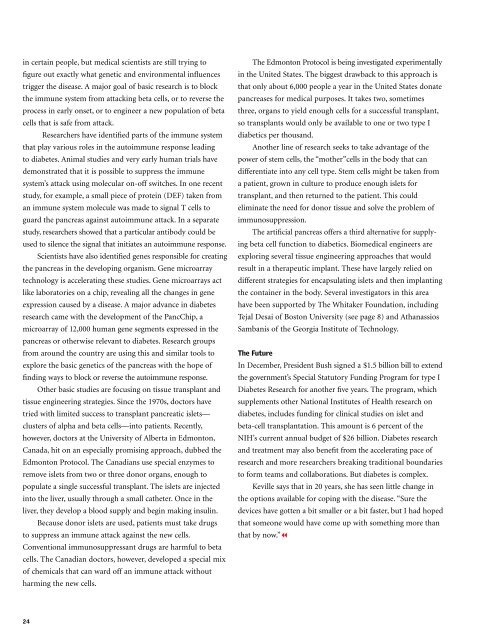Whitaker Foundation 2003 Annual Report - Advanced Materials ...
Whitaker Foundation 2003 Annual Report - Advanced Materials ...
Whitaker Foundation 2003 Annual Report - Advanced Materials ...
You also want an ePaper? Increase the reach of your titles
YUMPU automatically turns print PDFs into web optimized ePapers that Google loves.
in certain people, but medical scientists are still trying tofigure out exactly what genetic and environmental influencestrigger the disease. A major goal of basic research is to blockthe immune system from attacking beta cells, or to reverse theprocess in early onset, or to engineer a new population of betacells that is safe from attack.Researchers have identified parts of the immune systemthat play various roles in the autoimmune response leadingto diabetes. Animal studies and very early human trials havedemonstrated that it is possible to suppress the immunesystem’s attack using molecular on-off switches. In one recentstudy, for example, a small piece of protein (DEF) taken froman immune system molecule was made to signal T cells toguard the pancreas against autoimmune attack. In a separatestudy, researchers showed that a particular antibody could beused to silence the signal that initiates an autoimmune response.Scientists have also identified genes responsible for creatingthe pancreas in the developing organism. Gene microarraytechnology is accelerating these studies. Gene microarrays actlike laboratories on a chip, revealing all the changes in geneexpression caused by a disease. A major advance in diabetesresearch came with the development of the PancChip, amicroarray of 12,000 human gene segments expressed in thepancreas or otherwise relevant to diabetes. Research groupsfrom around the country are using this and similar tools toexplore the basic genetics of the pancreas with the hope offinding ways to block or reverse the autoimmune response.Other basic studies are focusing on tissue transplant andtissue engineering strategies. Since the 1970s, doctors havetried with limited success to transplant pancreatic islets—clusters of alpha and beta cells—into patients. Recently,however, doctors at the University of Alberta in Edmonton,Canada, hit on an especially promising approach, dubbed theEdmonton Protocol. The Canadians use special enzymes toremove islets from two or three donor organs, enough topopulate a single successful transplant. The islets are injectedinto the liver, usually through a small catheter. Once in theliver, they develop a blood supply and begin making insulin.Because donor islets are used, patients must take drugsto suppress an immune attack against the new cells.Conventional immunosuppressant drugs are harmful to betacells. The Canadian doctors, however, developed a special mixof chemicals that can ward off an immune attack withoutharming the new cells.The Edmonton Protocol is being investigated experimentallyin the United States. The biggest drawback to this approach isthat only about 6,000 people a year in the United States donatepancreases for medical purposes. It takes two, sometimesthree, organs to yield enough cells for a successful transplant,so transplants would only be available to one or two type Idiabetics per thousand.Another line of research seeks to take advantage of thepower of stem cells, the “mother”cells in the body that candifferentiate into any cell type. Stem cells might be taken froma patient, grown in culture to produce enough islets fortransplant, and then returned to the patient. This couldeliminate the need for donor tissue and solve the problem ofimmunosuppression.The artificial pancreas offers a third alternative for supplyingbeta cell function to diabetics. Biomedical engineers areexploring several tissue engineering approaches that wouldresult in a therapeutic implant. These have largely relied ondifferent strategies for encapsulating islets and then implantingthe container in the body. Several investigators in this areahave been supported by The <strong>Whitaker</strong> <strong>Foundation</strong>, includingTejal Desai of Boston University (see page 8) and AthanassiosSambanis of the Georgia Institute of Technology.The FutureIn December, President Bush signed a $1.5 billion bill to extendthe government’s Special Statutory Funding Program for type IDiabetes Research for another five years. The program, whichsupplements other National Institutes of Health research ondiabetes, includes funding for clinical studies on islet andbeta-cell transplantation. This amount is 6 percent of theNIH’s current annual budget of $26 billion. Diabetes researchand treatment may also benefit from the accelerating pace ofresearch and more researchers breaking traditional boundariesto form teams and collaborations. But diabetes is complex.Keville says that in 20 years, she has seen little change inthe options available for coping with the disease. “Sure thedevices have gotten a bit smaller or a bit faster, but I had hopedthat someone would have come up with something more thanthat by now.”24


